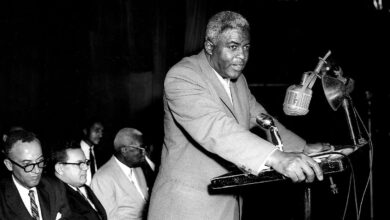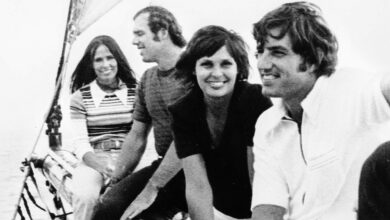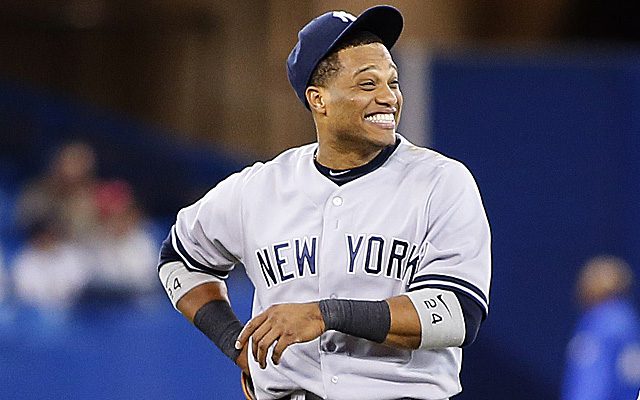

A month ago, the team I despise most won the World Series … ugh. Even though it pains me to say this, the New York Yankees should take a page out of the Boston Red Sox 2012-2013 playbook. The needed changes aren’t nearly as drastic as the Sox made last year, but the Yankees should still use what their hated rivals did as a model during the offseason.
The free-agent landscape is changing with many teams now locking up young talent before they reach arbitration. The problem for the Yanks: It doesn’t appear they have very many difference-makers in the minors; and even that famous New York spin can’t convince trade partners of anything different. In the past, the Yankees would find a team willing to believe Mason Williams or Tyler Austin were top-tier prospects. They would pry a superstar like Giancarlo Stanton by floating the names of Dellin Betances or Manny Banuelos. Today, not so much. Young, controllable talent is what teams want these days when trading veteran talent.
As I write this, I’m reading reports saying the Yankees will aggressively pursue Shin-Soo Choo, Masahiro Tanaka, Carlos Beltran and dole out an insane contract to retain Robinson Cano. They also just spent $85 million on Brian McCann for five years; however, I personally feel this was a target they needed. While some of these players should be on the radar, if they do spend the $300 million some are reporting for Cano, one thing is certain: The Yankees have not learned from their mistakes.
Since 2010, the team that has signed the most expensive position player has missed the playoffs. In 2010, the Red Sox signed Carl Crawford to a ridiculous seven-year, $142 million contract, and we all know how that turned out. In 2011 and 2012, the Angels dished out 10 years and $250 million for Albert Pujols and five years and $123 million on Josh Hamilton, respectively, only to miss the playoffs each year. Simply put, these mega-deals aren’t netting the results the price calls for.
So, how does one go about fixing the Yankees? For once, it calls for something the team has completely moved away from: Patience — both in the front office and on the diamond. In the front office, they need to adapt to the changing MLB landscape and free agency. Instead of pouring egregious amounts of money into older free agents, they need to dedicate a sizable chunk of cash to scouting and minor league development.
For a team that took so much pride in building a core group of players, which yielded five championships since 1996, they haven’t developed another home-grown core. There have been attempts, like when they had Phil Hughes, Joba Chamberlain and Ian Kennedy. However, Hughes was a bust, they completely destroyed Chamberlain and they shipped Kennedy off before he could amount to anything. In defense of the Kennedy trade, they did receive Curtis Granderson for him, and Kennedy probably would not have amounted to more than a fourth or fifth starter.
One thing completely lacking here is any mention of home-grown position players. For every Brett Gardner they have five David Adams’, and they will never be able to produce a solid core at that rate. This means the front office has to have a little patience with the talented kids they draft. Williams, Austin, Slade Heathcott and Gary Sanchez all had “down” years and didn’t progress as expected. In the past, the team would handle this by spending an absolute ton in free agency. It appears they may do that again, but if these kids are as good as the team bills them to be, give them a little time. They are all incredibly young — 23 and younger. With players that young, give them a little wiggle room and see what happens.
The Yankees need to get back to what they used to do better than most teams: get on base. The fact the 2013 team was able to win 85 games with a .307 team on-base percentage is absolutely mind-blowing. They had four regulars this season who didn’t crack a .300 on-base percentage. If these players don’t get on base, they don’t score runs. When the Yankees aren’t scoring runs, they don’t win. The last time the Yankees won the World Series, in 2009, they had a team OBP of .362. That isn’t a coincidence.
Now, I am not one who completely buys into moneyball and all that comes with it. But I do buy into teams getting on base. Not only does it produce opportunities to score runs, but it makes opposing pitchers throw a ton of pitches and make early exits. That’s why, this offseason, the Yankees should take a page out of the Sox playbook and look to sign some grinders. Here are moves I believe the Yankees should make, without breaking the bank.
Whom to let go?
Not that this is a shocking statement, but the Yankees need to let go of Hughes, Chamberlain, Travis Hafner, Lyle Overbay and Kevin Youkilis. There is absolutely no reason any of these players should return. Yes, Overbay filled in nicely, but let’s be honest, he’s just not that good. Hafner filled in with production early in the season but then fell off a cliff. Hughes would be better suited to go out West (Angels maybe?) and Chamberlain’s ship has long sailed. Chalk that demise, partically, up to the Yankees completely mismanaging him. But some team will offer him something, and he may find it again; who knows. I would let Granderson go, only if he turned down a one-year qualifying offer, which he did. My guess is he would want to return on a one-year deal to prove he deserves a multi-year contract. Then there’s Youkilis; was he really on this team this season?
Now, the one that will get Yankees fans up in arms, for sure: Robinson Cano. Is there a better second baseman in the game? No, there is not. Is there a home-grown Yankee who fits the superstar mold, aside from him, once Jeter retires? No, there isn’t one in sight. Would I pay him $305 million and 10 years? Absolutely not.
This is the type of contract that has absolutely burned the Yankees in the past. It’s not so much the annual amount, it’s the years. At the end of the 10-year contract, he would be 41 and, in this post-steroid age, how many 41-year-olds justify $30 million a season? The argument is he can DH or play 1B once he gets too old. Well, didn’t they say that about A-Rod, too? How’s that turned out? The only way I would re-sign Cano is if he signed for seven years or less. I may even go higher than $30 million a year at seven years. After seven years, he will be 38 and that is a way easier pill to swallow. Another reason the Yankees shouldn’t budge: What other team is willing to offer him more than a seven-year deal? Teams are learning that insane contracts aren’t paying off, thank you very much Mr. Pujols.
Fans will respond with, “this is New York, we need to win now.” That’s true, the team philosophy has always been to win now and worry about the rest later. But in this case, in this age, throwing that type of money at problems will only put the Yankees in a bigger hole down the road.
What follows assumes that Cano is back on a contract that makes sense for the Yankees or isn’t back at all. This is also under the assumption the A-Rod fiasco gets resolved with him being suspended, saving the Yankees some serious cash.
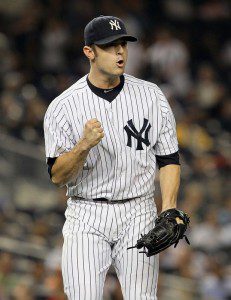
Bullpen
One of the Yankees strengths in 2013 was their bullpen; however, they lacked a second reliable lefty. As teams are beginning to realize, there isn’t a need to overspend on bullpen arms. Instead, groom some of the triple-A kids. So, for the righties, the Yankees should have enough arms to be potent. Obviously, replacing a legend like Mo won’t be easy, but if given the chance, David Robertson should succeed. He hasn’t had great success in the limited time he’s had as closer, but, I would give him a shot. Here are some bullpen arms I would target for 2014 and beyond:
Boone Logan — If you want to look at in-house free agents, I would offer him a two- or three-year deal, but I wouldn’t go longer than that. I imagine he would get a little more than his $3.15 million 2013 salary, but I wouldn’t go higher than $4 million a year.
Oliver Perez — New York fans may think I’m insane for even suggesting this, but Perez wasn’t that bad in a bullpen role last year. His 3.74 ERA was a little high for a reliever but, under the right circumstances, Perez can succeed. I wouldn’t go more than a two-year deal.
Jesse Crain — I would go after Crain for a few reasons. For a reliever, he’s not that old (33 in July), he can pitch in any inning after the sixth, he’s coming off of a season where he was insanely dominant and he’s coming off of an injury. In 36.2 innings last year, Crain pitched to a 0.74 ERA, and he has pitched to an ERA under 3.60 in eight out of 10 seasons. Likely, he will be searching for more than two years. However, if the Yankees can get him for two years and a third-year option, I would jump on it. He has a tough mentality and could easily slide into any of the later-inning spots should Robertson fail as a closer.
J.P. Howell — I would be shocked if Howell didn’t return to the Dodgers. If they let him go, and I’m Brian Cashman, I’m going after him. Relatively young (31 in April) and removing his injury-plagued seasons, Howell was very effective against both righties and lefties, and he has AL East experience. If the Dodgers let him walk, I would offer three years with a ton of incentives based on his injury history.
Scott Downs — If they Yanks swing and miss on all of their other left-handed options, Downs wouldn’t be a terrible signing — if they can get him for one year. He’s a little older than the others on this list, but if you get him for a year and under $2 million, he still can be effective.
Closers — Personally, I would like to see Robertson get a shot at closing. However, I understand if the Yankees hesitate since there are a decent amount of closers on the market; however, I wouldn’t pay anything more than $9 million a year, and I wouldn’t give anything more than two years to the likes of Joe Nathan, Grant Balfour or Joaquin Benoit. Seeing how none of these closers would likely accept a deal under $10 million, or for less than two years, I would stick with Robertson. Plus, if I am a free-agent closer, the last thing I want to do is try to be the guy who has to replace Mariano Rivera.
Starting pitchers
The starting pitching market could prove deadly to the Yankees this offseason. They have the potential to do what they’ve done in the past and spend a crazy amount of dough on players who, quite frankly, don’t deserve it (i.e., Carl Pavano, Jaret Wright). This is even more dangerous because, after CC Sabathia crashed and burned this year and Ivan Nova’s last two seasons have resembled Mr. Toad’s Wild Ride, the Yankees have no one else penciled into their starting rotation right now. Who knows if Michael Pineda will be able to give anything, and Phelps probably could be a nice number five, but I still wouldn’t go after the likes of Matt Garza, Ervin Santana or Ricky Nolasco. Let’s put this in perspective: Jason Vargas just received four years and $32 million. Jason Vargas who owns a career ERA+ of 91. What in the world do you think it’ll take to sign one of the three listed above? I’ll tell you how much, way too much. So, who should they sign? Let’s examine.
Masahiro Tanaka — Hypocrite right? Why would they dish out cash for a player with zero major league experience, while passing on the pitchers listed above? For starters, the posting fee (if he’s posted) would not go against the luxury tax for 2014. Second, Tanaka is young at 25. Third, while he might not have Yu Darvish stuff, scouts agree he has the stuff and the makeup to be successful in the majors. If any of these pitchers deserve a sizable chunk of change, it’s a guy who is 25 and can help the Yanks for a few years. In my opinion, he’s the only free-agent pitcher who warrants a five-year deal.
Hiroki Kuroda — Assuming Kuroda wants to return and not retire, ink him in for another one-year deal, which is his preference. Kuroda pitched well again for the Yanks, save for the final six weeks of the season. If he’s brought back with Tanaka, he would slot in nicely as a number two or three. Even though I would hesitate to dish out $15 or $16 million for a guy who fell so far off in the second half, for the long-term plans of the Yankees, he fits the mold. I would rather have him on the books for $16 million for one year than Garza or Santana on the books for an equal yearly amount and for five years. Another one-year, $15 million or $16 million deal could be in the cards.
One has to figure Ubaldo Jimenez, Garza and Santana will be looking for at least five years. If so, I wouldn’t touch them. Even though they are all relatively young, they are all going to be in their mid 30s at the end of a five-year deal, and there’s no way I can justify giving them $15 million a year over the life of a contract like that. If Scott Kazmir can be had at two or three years at $12 million, I would give that a shot as Kazmir is relatively young, left-handed and he can still strike batters out. He’s also an injury risk, so the Yankees should only offer him a contract on their terms. As far as short-term solutions, they could do a lot worse than taking fliers on guys like Clayton Richard, James McDonald and, dare I even say it, the player formerly known as Fausto Carmona. These would all be low-risk, potentially medium-reward signings that could probably be had for cheap.
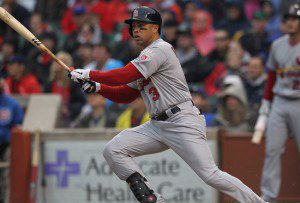
Position players
This past weekend, the Yankees agreed with McCann on a five-year, $85 million contract with a sixth year vesting option. I think if they are going to dish out some significant cash this offseason on a player not named Robinson Cano, they hit the jackpot with this signing. A $17 million a year contract may seem a little steep, but you’re getting a left-handed power bat who can guide a pitching staff as well as a player who can move to DH or 1B as he ages. I love this signing because they will not have to rush Sanchez to the majors. This gives Sanchez a little time to get more seasoning before he is ready to take over. When he is ready, McCann can slide over to DH and spell Mark Teixeira at first base. They also reportedly re-signed Brendan Ryan to back up a returning Jeter, which is not a bad signing, no matter how terrible of an offensive player he is. If the Yankees rebound and produce as they should, Ryan shouldn’t need to hit a lick, which he’s proven he can’t. The Yankees should only need him to catch the ball, which he does very well. If the Yankees find themselves needing a .275 season from Ryan, then they are in trouble.
So, should the Yankees go out and throw a ton of money at Choo and Beltran? Let’s examine.
Carlos Beltran — If Beltran can be had for one or two years at $12 million-$14 million a year, do it. It would represent a sizable upgrade over the slop they trotted out there last season as Beltran would most likely play right field and DH. This would force Ichiro and Vernon Wells into the fourth and fifth outfielder slots, which they are much better suited for at this point in their careers. It also appears Granderson will not return, so getting a player on a one- or two-year deal to replace him would be ideal. I would much rather see Beltran for a maximum of two years than the seven or eight it will take to get Choo. With Beltran on board, it gives Williams, Heathcott and Austin a few more years to develop into the players the Yankees still hope they will be.
Michael Morse — If they whiff on Beltran, I would look at Morse. Yes, he isn’t great in the outfield. Yes, he is injury prone. And, yes, the guy can mash. Assuming Beltran is not on the roster, I would offer Morse, for his power potential alone, one year and say $3 million-$6 million. If platooned with Ichiro in right, he also wouldn’t be as exposed out there, limiting his injury risk. Again, he would be a temporary solution until the kids are ready to produce.
Omar Infante/Kelly Johnson/Juan Uribe — This assumes Robinson Cano goes elsewhere. Any one of these players could help shoulder the burden of losing Cano. I don’t think the Yankees will let Robinson Cano go, but if they do, Infante probably has more flexibility and would be their number-one choice. Johnson has the better bat of the three and Uribe would probably be their last resort. Either of the three would be a stop gap until the Yankees re-group from the shock of losing their best player.
Mark Reynolds — Reynolds did a decent job in limited PA’s last year, and I feel there would be a mutual interest in bringing him back. He can provide some backup to 1B or 3B, and he can provide some needed right-handed pop off of the bench. He also can deliver a mess of strikeouts, so I would only bring him back as a part-time player on a one-year deal. I wouldn’t go higher than $1.5 million on a player like Reynolds.
So, there you have it, how to help bring the Yankees back to the top of the division. In order to get out of the burden of these long-term contracts for aging players the Yankees need to stop giving out long-term contracts to aging players! With the contracts discussed here, the Yankees would provide time for younger players to develop and contribute. These moves also would allow the Yankees to start lowering that massive payroll.
It will pain them to think this way, but in order to get back on top, they should seriously consider following the blueprint the Sox used to win a World Series trophy.


